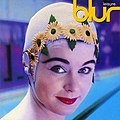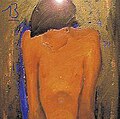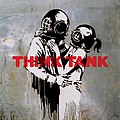Blur (band)
Blur |
|---|
Blur are an English rock band. Originally called Seymour, Blur formed in Colchester in 1989 at Goldsmiths College from the remnants of a band called Circus with vocalist/keyboardist Damon Albarn, guitarist/backing vocalist Graham Coxon and drummer Dave Rowntree; bassist Alex James joining the lineup later. Icons of the Britpop movement, they were one of the most critically and commercially successful bands of the 1990s and still exert considerable influence over fifteen years after their formation.
Blur were one of the English bands who appeared in the wake of The Stone Roses's eponymous debut album, mixing psychedelic pop rock with very loud guitars. Following an image change in the mid-1990s, the group emerged as one of the most popular bands in the UK, establishing themselves as heirs to the English pop tradition of The Kinks, The Small Faces, The Who, The Jam, Madness, and The Smiths. In the process, the group opened the doors for a new generation of bands which became labelled as Britpop. Blur were one of the leaders of the Britpop movement, but soon felt themselves bound to it; since they were one of its biggest bands, they nearly fell apart when the movement subsided. Through some reinvention, Blur reclaimed their position as an art pop rock band in the late 1990s by incorporating pseudo-indie-rock and lo-fi influences of American bands in the style of Pavement and R.E.M., which finally gave them their elusive American success in 1997.
In 2002, founding member Graham Coxon left the band, during recording sessions for their latest album Think Tank. But the band soldiered on and saw the project through in 2003. They also toured, hiring Simon Tong, former guitarist of The Verve. Since the end of their 2003 tour the band has been largely inactive as the members are working on solo projects. Although Coxon had shown no interest in rejoining Blur since his departure, he announced his contemplation at rejoining in November 2006, leading observers to speculate at a possible reunion. Alex James also said the following month that he met the latter and the two talked about Coxon rejoining the band. On December 30, 2006, unconfirmed reports of Coxon's return to Blur began to surface [1][2].
History
(1989-1992) Breakthrough and the Baggy scene
After "She's So High", the group's first single, made it into the Top 50, Morrissey producer Stephen Street contacted the band with a view to producing their debut album. The band agreed, beginning an incredibly successful partnership that would last for the next seven years. Street's exceptional production help, which aided the band immensely on their way to stardom, often lead to him being dubbed the band's fifth member by fans and press.
The follow-up to "She's So High", "There's No Other Way", went Top Ten. Both singles were included on Blur's debut album, Leisure. Although it received good reviews, the album managed to fit into both the dying Manchester pop scene and the Baggy scene, causing some journalists and music critics to dismiss the band as manufactured teen idols. During a tour of America the group became increasingly unhappy, often venting frustrations on each other, leading to several violent confrontations. For a couple of years, Blur struggled to abandon this title and prove the critics wrong. Their next single was called 'Bang',which was a massive underground hit.
(1993-1995) The Britpop years
The band, especially Albarn, began to formulate the idea of an album directed against American culture, originally titled Blur vs America, on which they began work upon their return to the UK. XTC's Andy Partridge was originally slated to produce the follow-up to Leisure (which later became Modern Life Is Rubbish), however the relationship between him and the band soon deteriorated. Stephen Street was again brought in to produce the album and, after spending nearly a year in the studio, the band delivered the finished album to Food records.
The song "Popscene" – branded as the herald of the Britpop boom – was recorded for Modern Life... but when released, charted at #32 in the UK Singles Chart and was dropped from the album (but later added to the American version). Food declared that Modern Life... needed a 'hit single' so the band went back into the studio and recorded "For Tomorrow", which turned out to be a minor hit in England. Food were ready to release the record, but Blur's American record company, SBK, said there was no American hit single on the record and asked them to return to the studio for a second time. They angrily complied and recorded "Chemical World" which pleased SBK; the song would become a minor alternative hit in the U.S. and charted at number 28 in the UK. Yet Modern Life... was set for release in the spring of 1993 when SBK asked Blur to re-record the album with producer Butch Vig (Nirvana and Sonic Youth). Irritated by the suggestion, the band refused. The record was finally released in May in Britain and appeared in the United States later the same year. Often cited as the first Britpop album, Modern Life Is Rubbish received good reviews in Britain, peaking at number 15 on the charts, yet it failed to make much of an impression in the U.S.
Modern Life... turned out to be a dry run for Blur's breakthrough album - Parklife, whose East End stylings were inspired by Martin Amis' London Fields. The follow-up entered the charts at number one and catapulted the band to stardom in Britain. The new wave dance-pop single "Girls & Boys" entered the charts at number five; the single managed to spend 15 weeks on the U.S. charts, peaking at number 52, but the album never cracked the charts. It was a different story in Britain, as Blur had a string of hit singles, including the ballad "To the End" and the mod anthem "Parklife", which featured narration by Phil Daniels, the star of the film version of the Who's Quadrophenia.
With the success of Parklife, Blur opened the door for many British bands who dominated the British pop culture in the mid-'90s and which were labelled as Britpop. Elastica, Pulp, the Boo Radleys, Supergrass, The Verve, Radiohead and numerous other bands all benefited from the band's success. By the beginning of 1995, Parklife went triple platinum and the band became superstars. The group spent the first half of 1995 recording their fourth album and playing occasional concerts, including a sold-out stadium show. February of that year saw Blur receive a yet unbeaten 4 awards at the Brit awards, for best album (Parklife), best video (Parklife), best single (Parklife) and best British group.
Blur released "Country House", the first single from their new album, in August amidst much media attention, as Albarn had requested the single's release moved up a week to compete with the release of "Roll With It", a new single from Blur's chief rivals, Oasis - sparking the much hyped "Battle of Britpop". The strategy however backfired, as even though the band won the battle, with "Country House" beating "Roll With It" to become the group's first number one single, they ultimately lost the war, as Oasis became Britain's biggest band at the time with their second album, (What's the Story) Morning Glory?, overshadowing Blur's fourth The Great Escape. While The Great Escape entered the UK charts at number one and earned overwhelmingly positive reviews, it did not sell as well, and by the end of 1995, Blur were seen as has-beens. This perception was cemented by their failing to make an impression on the American market, in contrast to Oasis.
(1996-2001) A New Direction
Struggling under negative press and weak public support, Blur nearly broke up in February 1996, following a violent drug scuffle between Coxon and Albarn. The band decided to rest between the end of touring in March and the beginning of recording their next album in summer. Recording for the band's fifth album began in summer and ended in winter. Relations in the band had improved and by December, the album had been mixed and mastered. By the end of 1996, Albarn's interests had changed from British pop to American indie rock and lo-fi - genres that Graham Coxon had been supporting for years. These influences were obvious in Blur's eponymous fifth album, Blur, which was released in February 1997 to warm reviews, rivalling those of Parklife.
However the band's reinvention didn't earn them initially warm reviews in UK - the album and the first single, "Beetlebum" (said to be heavily influenced by Albarn's girlfriend and Elastica frontwoman Justine Frischmann's heroin addiction) debuted at number one but quickly fell down the charts - as the group's mass audience didn't all accept this incarnation. In the U.S. the record received strong reviews and the album and its second single "Song 2" became a large hit, helped by its popularity as an anthem at sports games. The album reached #61 on the Billboard Top 200 chart and achieving gold status in December of that year, while "Song 2" peaked at #6 on the magazine's Modern Rock chart. "Song 2" has extended popularity, being played at U.S. sports events, though it has also branded Blur as a one hit wonder. The album wasn't making much of an impression in Britain until Autumn of that year, partly because during this time Radiohead and The Verve had released their monumental albums OK Computer and Urban Hymns and critics, fans and press didn't pay much attention to Blur. The Album's American success was eventually repeated in Britain and by the end of the year Blur bounced back into the charts. It show-cased the natural evolution of the band beyond their roots, while combining earlier work in a successful blend of Britpop and American lo-fi, which came as a stark contrast to the much-criticized third album Be Here Now by their old rivals Oasis. The tables had now turned since Blur were reaching new heights with their Blur while Oasis were going nowhere fast with the release of Be Here Now. Many critics credit the two albums as the beginning of the decline for the Britpop Era.
The band decided to take a different approach to their next album, and so parted ways with long-time producer and collaborator Stephen Street. Street had helped immensely in establishing the band and the move was criticised by some fans but, nevertheless, in 1999, Blur returned with 13. It was lyrically dominated by the end of Albarn's turbulent relationship with Justine Frischmann, Elastica frontwoman and Albarn's struggle with an on-going substance abuse problem. Graham Coxon had even bigger artistic input, contributing vocals to some of the songs, including the hit single "Coffee & TV", and designing the cover of the sleeve. Darker in tone, the album was received very well, although not as well as their Britpop records.
Exhausted by incessant recording and touring through the world, the band took a hiatus, pausing only to release a box set of Blur's singles in August 1999 to celebrate their 10th anniversary. Albarn said that as they didn't stop for a decade, they needed a break. For a couple of years members of Blur engaged in a variety of side-projects around this time: Coxon made a number of solo albums, Alex James joined actor Keith Allen and artist Damien Hirst (who had both contributed their talents to the video for Blur's single, "Country House" in 1995) to form Fat Les, while Albarn formed the cartoon supergroup Gorillaz. Albarn also travelled to Mali on behalf of Oxfam, producing the fundraising album Mali Music.
(2002-2003) Coxon's departure and Think Tank
Recording for the next album got under way in Marrakesh, Morocco, in mid-2002, but tensions surfaced when Coxon, who had just given up a heavy alcohol addicton problem, began to appear emotionally and creatively distant to his bandmates, and reportedly failed to attend recording sessions. One of the main causes for this has been cited as the choice of Norman Cook (dance DJ Fatboy Slim) as the sessions' producer. After several weeks of rumour and uncertainty, Coxon confirmed that he had been asked to leave the band for reasons connected with his "attitude". Coxon only appears on the final track of the album "Battery in Your Leg" which Albarn said was the only song he ever wrote about the band.
Although Albarn has said that the door is always open for Coxon to return, a reunion of the original Blur line-up did not seem likely in the foreseeable future, particularly given the success of the guitarist's solo career since his departure and the band's relative inactivity.
The album resulting from the sessions, Think Tank, was released in May 2003. Instead of the catchy pop tunes of their early career or the alternative rock Blur made in their two previous albums, Think Tank was filled with brooding, atmospheric, heavy electronic sounds, a testament both to Albarn's increasing interest in electronica and his control over the group's creative direction. The album was largely recorded after Coxon quit the band; because of this, it features almost no electric guitar in the style of Blur's earlier albums, largely relying on backing vocals and other instruments to fill the void. Coxon's absence also meant that the album was almost entirely written by Albarn.
After the album the band supported the album with fairly successful tour and three top 30 singles: "Out of Time, "Crazy Beat" and "Good Song". For the tour they hired former The Verve guitarist Simon Tong, who collaborated with Damon in Gorillaz.
While Think Tank received generally enthusiastic reviews (notably from Rolling Stone, Mojo, Q, and Spin magazines), a minority of critics (including the All Music Guide) didn't warm to it. It was still yet another UK # 1 and managed their highest US position (# 56) in the still-impenetrable American market. The album was also nominated for Best album at the 2004 Brit Awards.
(2004-present) On hiatus again
Although the band intimated in some interviews that they might record a new album in 2004 this never materialised and in recent years all three remaining members have devoted their energy to solo projects. Meanwhile Coxon has rekindled his relationship with Stephen Street, to craft his most successful and accessible solo albums to date Happiness in Magazines (2004) and Love Travels at Illegal Speeds (2006).
Albarn released a follow-up Gorillaz album Demon Days in May 2005, which received significant praise, and was supported by the "Demon Days" world tour. In early 2006, Gorillaz received a Grammy award, for "Pop Collaboration With Vocals" for the song "Feel Good Inc".
In late July 2006, Albarn announced the formation of a band with Simon Tong, the Clash bassist Paul Simonon, and drummer Tony Allen. The band are expected to release their self-titled debut album The Good, the Bad and the Queen in January 2007. The album's first single - "Herculean" - was released on 30 October 2006. Alex James began working with pop singer Betty Boo in the band WigWam. They released the single "WigWam" in April 2006 and are currently working on their debut album. Dave Rowntree set up the animation company Nanomation which produced the South Park-esque Empire Square, shown on Channel 4 in early 2005. He is also drummer, and occasionally instrumentalist and vocalist for The Ailerons [3], who are reportedly working on their debut album.
Damon Albarn stated in a 2006 Q interview that he is still dedicated to Blur, but reluctant to tour without Coxon. Alex James has commented that he is hopeful to persuade Coxon to come back to Blur, and that he feels their best work is still to come. For his part, Coxon appears to be have thawed of late, telling Pitchfork in November 2006 that he had not ruled out a reunion. [4] In a BBC interview the following month, Alex James confirmed that he and Coxon had recently met up for the first time in a year and discussed reuniting; he described Coxon as "coming round to the idea" of rejoining the group [5]. Two December 30, 2006 reports support James' claims [6] [7].
Discography
Line-up
- Damon Albarn - vocals, guitar, keyboards, lead songwriting;
- Alex James - bass guitar, backing vocals;
- Dave Rowntree - drums and percussion, backing vocals;
Former members
- Graham Coxon - lead guitar, occasional lead vocals and songwriting, backing vocals (1989–2002);
Temporary members
- Simon Tong - lead guitar, filled in for Coxon during Blur's Think Tank 2003 tour;
Samples
Template:Multi-listen start Template:Multi-listen item Template:Multi-listen item Template:Multi-listen end
Trivia
- Albarn, Coxon and James attended Goldsmiths College, whose alumni also include Damien Hirst and Julian Opie. Hirst later directed the video for Blur's "Country House" and formed Fat Les with James. Opie created the vector-realistic images used on the cover of Blur's Best Of compilation.
- In a 1995 interview with The Observer, Noel Gallagher of Oasis expressed a wish for Damon Albarn and Alex James to "catch AIDS and die". He later appologized in a formal letter to Melody Maker.
See also
- Gorillaz
- The Good, the Bad and the Queen
- Elastica
- Fat Les
- Me Me Me
- WigWam
- William Orbit
- The Ailerons





